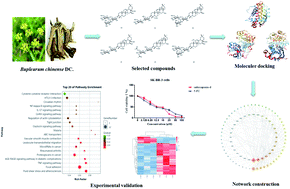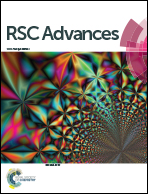Network pharmacology and RNA sequencing studies on triterpenoid saponins from Bupleurum chinense for the treatment of breast cancer†
Abstract
Breast cancer remains the most commonly diagnosed malignancy among women, which is frequently associated with adverse side-effects and high metastasis. Bupleurum chinense DC. has been empirically and extensively used as the core prescription for more than half of Chinese formulations for the adjuvant therapy of breast cancer, and its biological activity against breast cancer has been proven by both in vitro and in vivo experiments. Saikosaponin compounds are the characteristic constituent of B. chinense, which exhibit significant cytotoxicity toward several cancer cells. However, the specific mechanisms of these compounds in the treatment of breast cancer have not been comprehensively understood. Therefore, we aimed to determine more potentially therapeutic targets and investigate the biological mechanisms of B. chinense. In the present study, we adopted network pharmacology and bioinformatics analysis to facilitate this requirement. Consequently, the network analysis revealed that saikosaponin-f (39), saikosaponin-d (14), saikosaponin-c (26), saikosaponin-h (54), saikosaponin-g (41), 3′′,6′′-O-diacetylsaikosaponin-d (20), 11α-methoxy-saikosaponin-f (40), and 6′′-O-acetylsaikosaponin-b1 (48) might play important roles in the treatment of breast cancer. In addition, the apoptosis regulator Bcl-2 (BCL-2), C-X-C chemokine receptor type 4 (CXCR4), probable ATP-dependent RNA helicase DDX5 (DDX5), protein kinase C alpha (PRKCA), and proto-oncogene tyrosine-protein kinase Src (SRC) were the potential therapeutic targets that exhibited intense interactions. Mechanistically, a gene enrichment analysis revealed that the action of B. chinense against breast cancer was achieved by the regulation of several biological signaling pathways, such as pathways in cancer, PI3K-Akt signaling pathway, EGFR tyrosine kinase inhibitor resistance, microRNAs in cancer, etc. More importantly, we verified that the predictions involving saikosaponin-d by the cytotoxicity assay, apoptosis analysis, and RNA sequencing methods were partly consistent with those obtained from the network pharmacology prediction.



 Please wait while we load your content...
Please wait while we load your content...